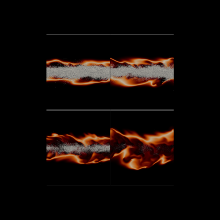Turbulent spray combustion is the most common technology in propulsion engineering, with particular importance for internal combustion engines. A short distance away from the fuel injectors the liquid jet has been atomised and the fuel is available as a fine dispersion of droplets that undergo evaporation and subsequent combustion. This stage of the process can be well described by Euler-Lagrange approaches for two phase flows, where the carrier phase is solved in the Eulerian framework, whereas the liquid droplets are tracked in a Lagrangian manner. However, in conventional Euler-Lagrange methods the processes of evaporation, fuel/oxidiser mixing and combustion, and their interaction with turbulence cannot be fully resolved. In this project we extend a modelling concept for turbulence-chemistry interactions referred to as multiple mapping conditioning (MMC) to spray combustion. MMC introduces an additional (second) set of Lagrangian particles, which are stochastic entities representing the local, instantaneous composition of the fluid phase. A sparse-Lagrangian formulation of MMC is used, where the number of stochastic particles is lower than the number of Eulerian grid cells. Turbulence is modelled by using the accurate large eddy simulation (LES) paradigm. The main project challenge lies in the coupling methods for the overall Euler-Lagrange-Lagrange model in LES. In particular, accurate methods for modelling the heat and mass transfer between the liquid fuel droplets and the sparse stochastic particle set that represents the gas phase need to be developed. To this end, an existing direct numerical simulation (DNS) configuration for pure gas flames is extended to spray combustion and provides accurate reference data for MMC model development. The final MMC-LES model is validated against the DNS and a series of detailed spray flame experiments.
Movie 1
Movie 1: Carrier-phase DNS of spray combustion in a double shear layer, where the fuel jet is initially located in the centre of the domain and surrounded by two counter-flowing oxidiser streams. The gas phase is coloured by the gas temperature ranging from 500K (black) to 2500K (bright yellow). The droplets are scaled according to their diameter (scaled up by a factor of 10). With advancing time the two streams mix, leading to combustion and droplet evaporation in the shear layer.
Movie 2
Movie 2: Carrier-phase DNS (left animation) and MMC (right animation) of spray combustion in a double shear layer. The central fuel jet is composed of gaseous nitrogen and pre-evaporated ethanol, and it carries liquid ethanol droplets. It is surrounded by two counter-flowing oxidiser streams (air). With advancing time the two streams mix, leading to droplet evaporation and turbulent combustion in the shear layer. The left animation shows the blue flame in the DNS field and the evaporating fuel droplets (grey spheres, scaled up by a factor of 10 for better visibility) that move with the turbulent flow. The right animation shows the two-phase MMC solution, where the gas phase is represented by stochastic particles (coloured by gas temperature), and grey spheres mark the fuel droplets.
Related publications
- M. Sontheimer, A. Kronenburg, and O. T. Stein, “A comparative study of two-phase coupling models for a sparse-Lagrangian particle method,” Proc. Combust. Inst., vol. 39, (2023).
- M. Sontheimer, A. Kronenburg, and O. T. Stein, “Two-phase coupling for MMC-LES of spray combustion,” Proc. Combust. Inst., vol. 38, pp. 3361–3369, (2021).
- M. Sontheimer, A. Kronenburg, and O. T. Stein, “Grid dependence of evaporation rates in Euler–Lagrange simulations of dilute sprays,” Combust. Flame, vol. 232, p. 111515, (2021).
- J. Kirchmann, A. Kronenburg, O. T. Stein, and M. J. Cleary, “Two-phase sparse-Lagrangian MMC-LES of dilute ethanol spray flames,” Proc. Combust. Inst., vol. 38, pp. 3343–3350, (2021).
- M. Sontheimer, A. Kronenburg, and O. T. Stein, “Effects of PSI-cell modeling on subgrid-scale mixture fraction variance for LES of spray combustion,” in 30. Deutscher Flammentag, 28-29 Sept, Hannover-Garbsen, Germany, (2021).
- M. Sontheimer, A. Kronenburg, and O. T. Stein, “Analysis of the particle-source-in-cell model for LES of spray combustion,” in 29. Deutscher Flammentag 2019, 17-18 June, Bochum, Germany, (2019).
- M. Sontheimer, A. Kronenburg, and O. T. Stein, “Analysis of Multiphase MMC Coupling Using DNS of a Reacting Double Shear Layer,” in Proc. 9th Europ. Combust. Meeting, Lisboa, Portugal, (2019).
- N. Khan, M. J. Cleary, O. T. Stein, and A. Kronenburg, “A two-phase MMC–LES model for turbulent spray flames,” Combust. Flame, vol. 193, pp. 424–439, (2018).
- M. N. Khan, L. F. Zhao, M. J. Cleary, R. W. Bilger, O. T. Stein, and A. Kronenburg, “A mixture fraction-based model for evaporation, pyrolysis and char conversion of dilute fuel dispersion,” in 19th Australasian Fluid Mech. Conf., Melbourne, Australia, (2014).
Contact

Andreas Kronenburg
Univ.-Prof. Dr.Director of the Institute



